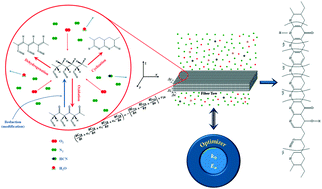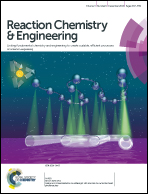A comprehensive chemical model for the preliminary steps of the thermal stabilization process in a carbon fibre manufacturing line†
Abstract
The thermal stabilisation process of the carbon fibre production line, as an energy consuming oxidation reaction, is diffusion limited. Therefore the kinetic parameters, estimated from traditional methods, cannot be applied due to the significance of oxygen diffusivity. Moreover, this process involves multiple chemical reaction systems, which are interconnected and often too complex to explain via analytical frameworks. One common solution to comprehend such a process and optimise its parameters is mathematical deterministic models. In the present study, a comprehensive deterministic model was developed to predict the kinetic parameters with a finite number of experiments by an optimisation algorithm. Then the model was used to study the progress of the process, particularly in the first steps of the process to explain the decrement of C![[double bond, length as m-dash]](https://www.rsc.org/images/entities/char_e001.gif) O bonds in the oxidised fibre by adding a reduction step to the stabilisation mechanism and considering the role of oxygen as a catalyst in cyclisation. The developed model is based on the structure of the PAN precursor, fibre tow and governing differential equations for the underlying phenomena, including chemical kinetics and mass transfer, associated with empirical relations for oxygen diffusivity and physical properties under isothermal conditions. The results presented up to 95% improvement in outcomes of the model for a pilot carbon fibre production line.
O bonds in the oxidised fibre by adding a reduction step to the stabilisation mechanism and considering the role of oxygen as a catalyst in cyclisation. The developed model is based on the structure of the PAN precursor, fibre tow and governing differential equations for the underlying phenomena, including chemical kinetics and mass transfer, associated with empirical relations for oxygen diffusivity and physical properties under isothermal conditions. The results presented up to 95% improvement in outcomes of the model for a pilot carbon fibre production line.



 Please wait while we load your content...
Please wait while we load your content...